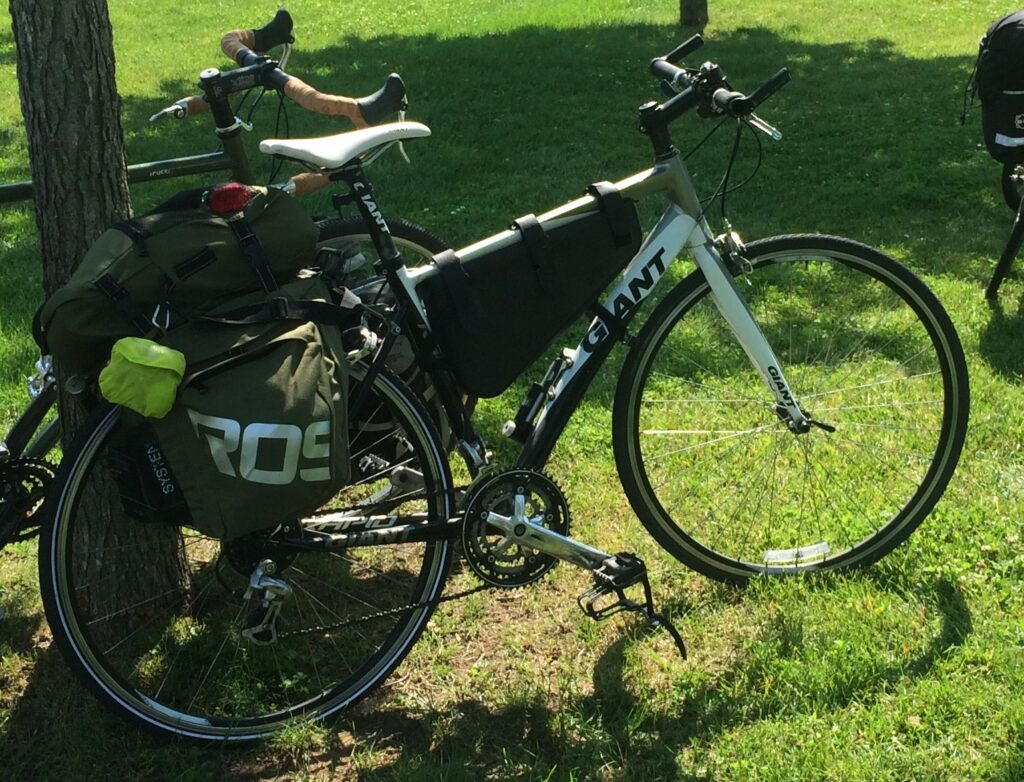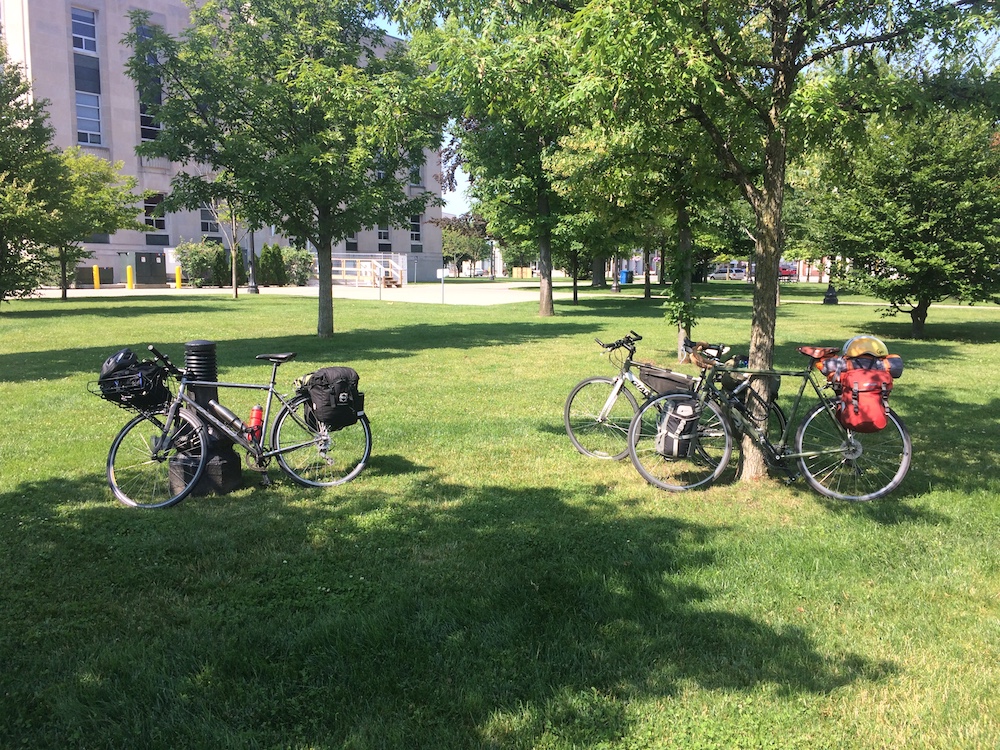My Bike Touring Setup (2021)
2021 was the first year I went on any multi-day trips on a bike. This post outlines the gear I used on these first trips, in hopes in might be useful to someone (I am not compensated to discuss any products or brands mentioned in this post). This was my first year touring—I started by using the bike I already owned, and buying cheap items I thought I might need. For context, all of my tours in 2021 were relatively short—between 1-3 days, and never more than 300km in one trip.
- My Bike Touring Setup (2021) (current)
- My Bike Touring Setup (2022)
- My Bike Touring Setup (2023)
The Bike
- 2010 Giant Rapid 3
- Style: Flat-bar hybrid bike with bar-ends
- Frame Type: Aluminum (Size M)
- Tire: 700 x 28 Kenda Kwest
- Pedals: Caged with Toe-clips
- Groupset: 3 x 8, Shimano Derailleurs (R443 & 2300), SRAM cassette, FSA BB/Cranks
- Everything stock, minus accessories
- See full specs for this bike here

Bags & Accessories
- Rockbros full-frame bag
- Roswheel Rear Panniers & Bag
- Osprey Backpack Rain Cover
- 2x Spare Inner Tubes
- Bontrager Portable Tire Pump
- Universal Rear Rack
- New brake pads
- Bell
- BV Bike Lights—front and rear
- Solar Power Bank—portable
- Allen Keys
Camping Gear & Extra Clothing
- Hikant Camping Hammock
- BESTEAM summer sleeping bag
- Patagonia Torrent Rain Jacket
- Baleaf Padded Bike Shorts
- An overpriced towel purchased mid-ride out of desperation
This is a pretty cheap setup that worked well enough. If you don’t plan on camping, a lot of this gear is also unnecessary.
Overall Review of This Setup
The Bike
The Giant Rapid 3 is a hybrid bike is designed for short, urban rides, which it is great for, however it’s definitely not an ideal touring bike…but it’s what I had at the time. I still own and like this bike for city riding and commuting, but if you’re looking for a new or used bike with longer rides in mind, I would probably stay away from flat-bar, hybrid bikes. The upright position it puts you in means you use more energy in windy conditions, and the gear ratios aren’t the best for fully-loaded hill climbs. I also think drop-bars are more comfortable given the wider variety of hand positions they offer, personally. But if a hybrid bike is all you have, you can certainly make minor adjustments to make it comfortable for touring or long rides—I did.
Ride Quality
Aluminum is a pretty harsh feeling metal on a bike when you are riding 5+ hours per day; I had never previously given much thought to frame material affecting ride quality. My hands went numb many times on a long gravel ride, and I felt like the flat bars weren’t the most comfortable, even with the bar-ends (though they helped to offer slightly different hand positions; I would take bar-ends vs. none at all). The aluminum frame, however, held the weight of the full panniers and bags without issue, and I never felt unstable and was able to move decently enough, in terms of average speed. The gear ratio of the Rapid 3 when loaded with bags was adequate for moderate hills, but if I bought a new bike, it would have even lower gears for steeper climbs. 700 x 28 tires were fine for the road and hard-packed gravel riding I did with this bike in 2021, however I did have one older tire explode on a bumpier gravel road. I recommend buying a fresh set of tires at the beginning of the season if you will be riding long distances. I think slightly larger tires would have also improved ride comfort (700 x 32 or larger for road/hard-packed gravel riding).
Geometry & Seat Position
I had almost zero knowledge of the importance of proper seat height and positioning when I started going on longer rides initially. This probably contributed to some brutal knee pain in one knee after the longest trip I did in 2021, which took at least a week to go back to normal. Overall, I attributed my knee pain to the following:
- Not properly setting my saddle height or fore/aft
- Pushing myself harder than I was conditioned for (I think this was the largest contributor to discomfort)
- The geometry of a hybrid bike being less suited to longer rides
I’ve since paid closer attention to my saddle positioning—I initially used the Lemond Method to get started and adjusted further in small increments, as needed. This has made a big improvement in terms of pain reduction of many types. Additionally, ensuring I’ve completed a number of smaller rides before embarking on a longer one has also reduced any sort of pain I feel on long rides now.
Pedals
Toe-clip pedals, in my opinion, suck. I think they also contributed to my knee pain in 2021 because my feet were forced into unnatural positions on the pedals; you need a very specific width of shoe to fit into toe clips properly. The stock pedals on the Rapid 3 were also not great for long rides. Buy good pedals if you can; they make a surprising difference in comfort—I have since upgraded to Shimano combo pedals which are much better.
The Additional Gear
Most of the cheap Amazon gear I purchased performed well for light touring, and I am still using much of it. Below are some comments about how some of the specific items above performed over the 2021 season:
- Camping Hammocks
- I purchased a hammock instead of a tent to reduce the weight I would have to carry on my bike. However, after using the hammock for all of the 2021 season, I realized that I do not sleep well in hammocks. It is difficult to sleep on your side, and they are more annoying to set up when you’re tired compared with a tent. Finding a camp site with the “right type” of trees is also sometimes an issue, and hammocks are colder at night compared to tents. For me personally, the lesser weight is not worth it; quality sleep is more important. That said, some people really prefer hammocks for sleeping—they may help reduce back pain in some circumstances.
- Rear Racks
- You do not need a heavy-duty, expensive rack unless you are loading your bike with a lot of heavy gear or riding pretty rough terrain. My rear rack is a cheap, light aluminum rack I’ve owned for 10+ years and am still using.
- Panniers
- High-quality panniers like Ortliebs are expensive; but they do seem worth it in some ways. My cheap, non-waterproof panniers are smaller than expensive ones and do have some minor design issues, but they are 1/4 of the price. I lined the insides with garbage bags, and nothing I was carrying got wet. In my opinion, cheap panniers are a good way to save money; their basic function is the same regardless of price and cheap panniers are easy to sell if you don’t want them anymore.
- Frame Bags
- Though also cheap, having a frame bag was very handy and I still use it. It allows for quick access to things without getting off your bike (phone, snacks, etc.).
- Padded Bike Shorts
- Again, I went cheap here. I am not sold on padded bike shorts, regardless of price (although I haven’t worn very expensive ones). They seem to simply replace one pressure point for another on your saddle, and are less comfortable than normal underwear. You also feel like you’re wearing a diaper constantly when you’re not on the bike.
- I would not recommend the Baleaf Amazon bike shorts I used in 2021—they ride up as you cycle and are pretty uncomfortable. They also fit very small.
- Rain Jackets
- If you are touring in warm weather, I am also not convinced you need expensive rain gear. When it rained for more than an hour, all of the rain gear I brought soaked through anyways. The only difference between having rain gear vs. having none at all is that it prolongs the initial period of staying dry by an hour or so, and the rain gear itself tends to dry out more quickly after getting wet compared to cotton clothing. My Patagonia rain jacket is the most expensive (and only) rain-specific jacket I’ve owned; it’s nice and breathable, but I think cheap one is probably fine too.
- Solar Power Banks
- Mine actually charged in the sun! I was skeptical because of how cheap it was on Amazon. I stored the power bank in a mesh pocket of my rear pannier that faced upwards to it charged while I rode; it was super handy to be able to recharge my cell phone endlessly.
Items I Wished I Had
- A small camping stove
- Having to struggle to find food in a small town after most things close is annoying; a small stove and food can be good to have on-hand.
- A sleeping pad
- I was very cold at night without one.
- New, wider bike tires
- I was lucky that there was a bike shop close by when my rear tire (both tube and tire) exploded on a trip, but if it had happened far from a town, it would have been the end of the trip. I also realized the benefits of having slightly wider tires for supporting all your gear, and for making the bike ride more comfortably overall.
- A foldable spare tire
- Thankfully I was close to a bike shop when I lost a tire in 2021; but it made me paranoid about ruining a tire in the middle of nowhere (the tire, not an innertube).
Items I Wished I Left at Home
- A rain cover for my bags
- This was pointless; it soaked through eventually like all my other rain gear. Garbage bags inside the panniers were unbeatable and free.
- An electric toothbrush
- I don’t know what I was thinking bringing this instead of a manual brush. The battery never died but it took up too much extra space and weight.
- Allen keys
- A full set of Allen keys was not necessary and added extra weight to my bike.
- A U-lock bike lock
- I brought a full bike lock thinking I might need it at some point; but I was never too far from my bike and a much lighter cable lock, or no lock at all, would probably have been fine. U-locks are very heavy.
- My wallet
- I mean my entire wallet here; I only really needed a couple cards and some cash. My wallet took up a surprising amount of space in my frame bag.
- My Bike Touring Setup (2021) (current)
- My Bike Touring Setup (2022)
- My Bike Touring Setup (2023)
